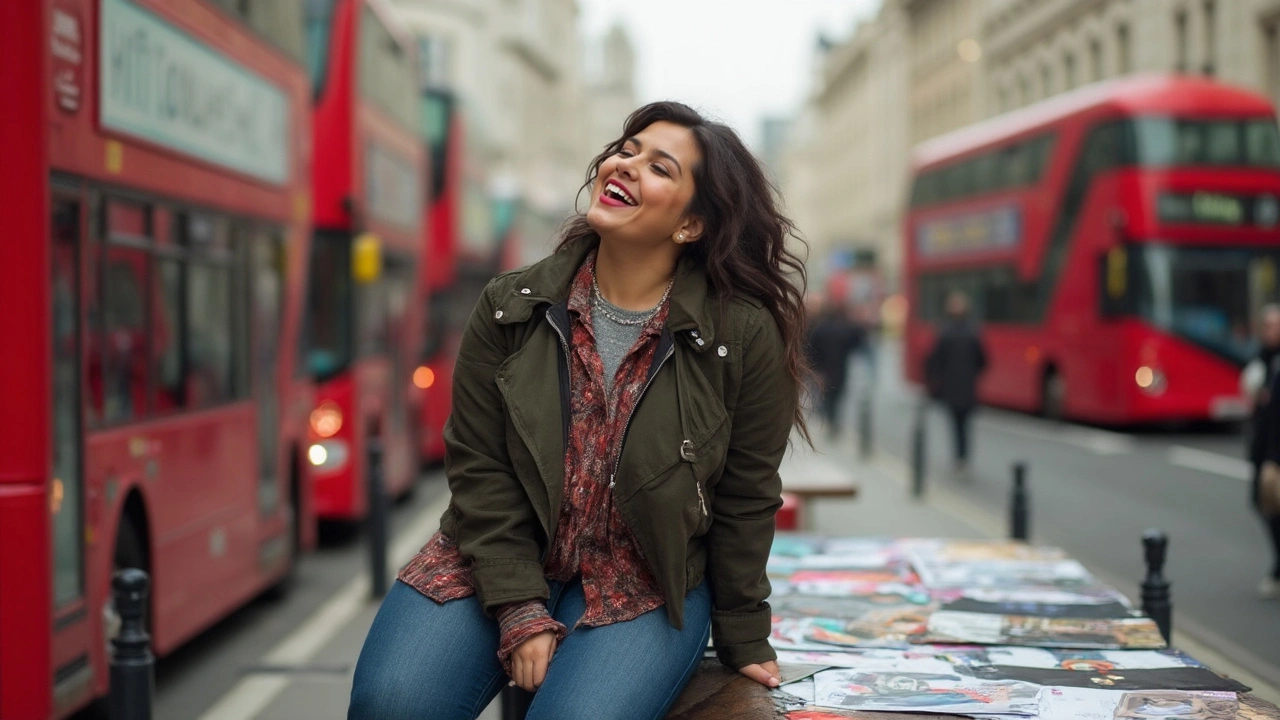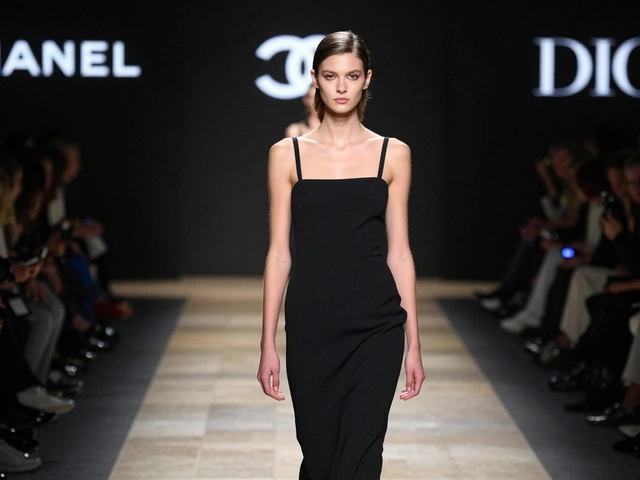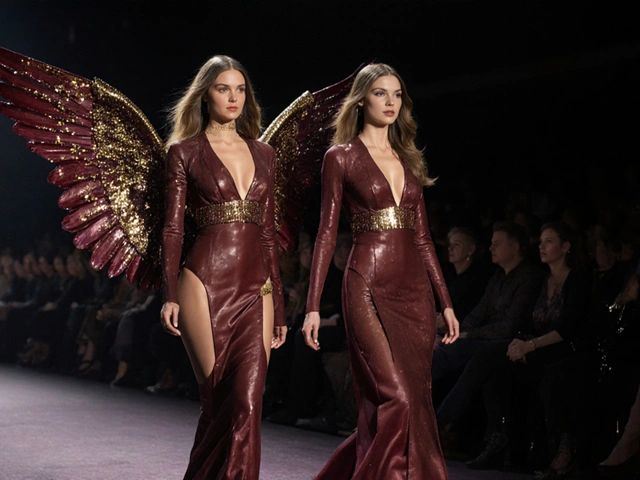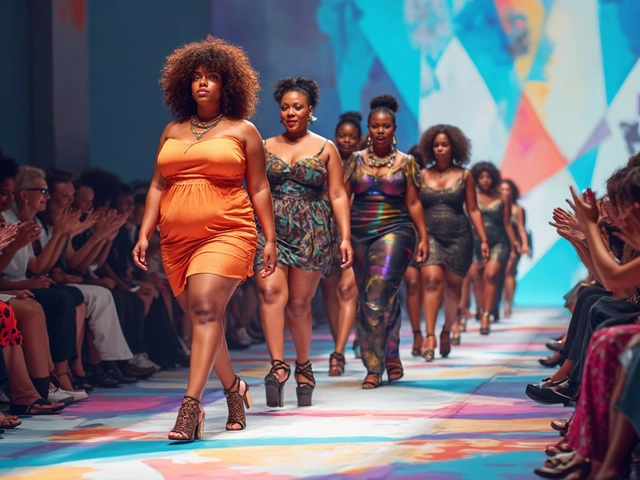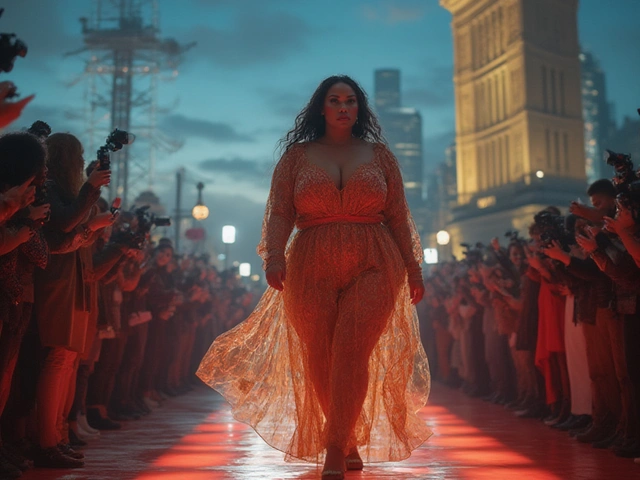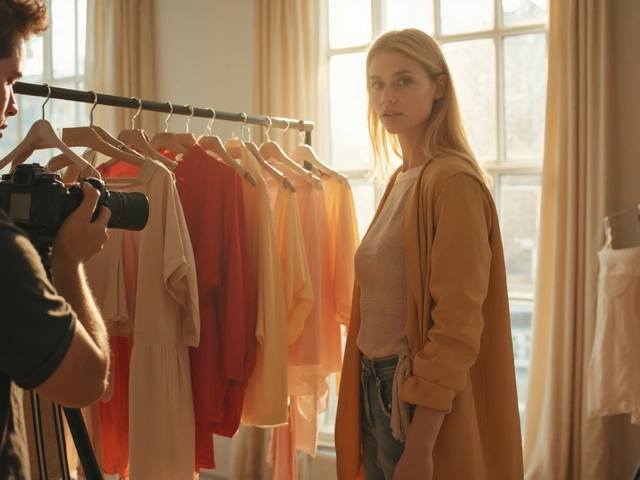Your model portfolio is your business card. It should give anyone who sees it a fast, clear picture of who you are as a model. For plus-size talent, this isn’t about squeezing into trends or hiding your body. It’s about looking comfortable, showing emotion, and giving agents proof that you can take direction and sell a vibe.
If you’ve been scrolling through polished portfolios and thinking, “Do I need wild clothes? Heavy edits?”—stop. Clean, simple shots where your personality shines always beat overdone glamour. Agencies want to see real skin texture, confidence, and clothes that fit well. One industry fact: natural light is your friend. Overly lit studio shots? Not so much unless you’re going for a magazine-style look—save that for later.
You don’t need a dozen outfits or a professional glam squad to get started. Start with a mix of fitted basics (think: jeans and a plain tee), a casual-dressy option, and one statement piece that feels like you. Throw in clean, makeup-light headshots too. Got stretch marks or visible scars? Don’t worry about hiding them—brands are asking for relatability over perfection in 2025. Plus-size models who book jobs show range: different looks and moods across 8-15 crisp, well-lit photos. You can snap these with a pro photographer, but your phone’s camera can handle the basics until you’re ready to book gigs and invest more.
- What Makes a Strong Plus-Size Model Portfolio
- Essential Shot List: What Agencies Want
- Finding the Right Photographer
- Nailing Wardrobe and Styling
- Posing and Confidence Tips
- What to Avoid: Rookie Mistakes
What Makes a Strong Plus-Size Model Portfolio
Your portfolio should be more than a slideshow of your best angles—it actually needs to prove that you’re bookable. For plus-size model hopefuls, your shots need to show range and a sense of comfort in your body. Agencies in the US and UK both say the single most common mistake is portfolios where all images look the same or the vibe feels forced.
Here’s what makes a knockout portfolio for plus-size talent today:
- Variety of Shots: Include headshots, half-body, and full-body images. Don’t stick to only one mood or look—mix it up with casual, styled, and even fitness shots if that fits you.
- Natural Presentation: Keep at least a few pictures makeup-light and free from heavy editing, so your skin and features are visible. These shots help agencies trust what they’re seeing.
- Body Positivity: Make sure your posing doesn’t look like you’re hiding. Stand open, try seated and movement shots, and let your confidence come through.
- Clear, Consistent Lighting: When in doubt, shoot with daylight near a window—the difference in skin tone and detail is significant according to agency feedback from Curve Model Management.
- Professional Polish: While you don’t need Vogue-level photos, blurry or dark shots can get you ignored. Aim for clean, sharp photos with uncluttered backgrounds.
Agencies and clients now want to see a wider range of sizes and real bodies. According to a 2024 Model Alliance survey, 38% of brands increased their demand for plus-size and curve models compared to the previous year. Here’s a quick look at the must-haves versus the not-worth-its:
| Portfolio Element | Must-Have? | Why |
|---|---|---|
| Crisp Headshot | ✔️ | Shows face, confidence, and versatility |
| Body Diversity (clothed & fitted) | ✔️ | Proves you can model different wardrobes |
| Heavily Filtered Photos | ❌ | Agencies want authenticity, not filters |
| Messy Backgrounds | ❌ | Distracts from you, not the vibe |
| Simple Styling, Good Fit | ✔️ | Clothes should compliment, not distract |
Don’t just take my word for it either:
"A strong portfolio isn’t about hiding flaws or fitting trends. It’s about showing confidence, range, and why a brand should cast you. Real, clear photos beat over-posed ones every time." — Jess Weiner, consultant for IMG Models
Before you pay for extra photos, look honestly at your shots. Do you see the best version of yourself, not just looks you think are expected? That’s the bar for a strong plus-size portfolio—and what agencies are booking in 2025.
Essential Shot List: What Agencies Want
If you want agencies to actually call you back, you need the right mix of shots in your model portfolio. Agencies—big and small—tend to ask for the same basic lineup, whether you're just starting or already booking jobs. Here’s what needs to be in your set, especially if you’re aiming to stand out as a plus-size model in 2025:
- Polished headshot: No heavy makeup, no wild props—just you, clean and confident. They need to see your real face, including your skin texture and natural features.
- Full-body shot: Jeans and a tank or fitted top work best. Agencies want to see your body proportions with no distractions from baggy clothes or weird angles.
- Profile/side shot: A simple side or three-quarter angle gives clients a sense of your shape and how you photograph beyond dead-on poses.
- Commercial smile shot: Show a big, natural smile. Most clients want to see warmth and approachability, especially for lifestyle brands.
- Editorial/fashion shot: Try one shot with a bit more attitude or mood—think magazine vibes, different lighting, or slightly bolder styling.
- Movement/action shot: Something like a mid-walk, playful jump, or laughing while moving. Agencies love seeing that you’re relaxed in front of the camera.
Don’t forget, agencies want to scroll fast—so skip stuffy poses and overcrowded backgrounds. Keep each shot clean, solid, and focused on you, not your setting.
Here’s a simple table of the typical requirements top U.S. agencies ask for in plus-size portfolios, pulled from open casting calls and agency guidelines as of mid-2025:
| Type of Shot | Recommended Outfit | Photo Style |
|---|---|---|
| Headshot | Neutral top, light makeup | Natural light, close-up |
| Full-Body | Fitted jeans & tank | Minimal background, standing pose |
| Profile/Side | Same as full-body | Side or three-quarter angle |
| Smile (Commercial) | Simple, bright top | Mid or close-face, natural smile |
| Editorial/Fashion | Statement piece | Dramatic light or pose |
| Movement/Action | Comfortable, basic outfit | Walking or moving shot |
Most agencies say six to eight good images beat a giant gallery of so-so ones. If they like what they see, you’ll get called for a test shoot where you can then add more variety. And don’t buy into the myth that plus-size means just one look—agencies love models who can show everything from a serious look to a toothy grin to a spontaneous pose. The more ways you can look genuine on camera, the more doors you’ll open.
Finding the Right Photographer
Picking a photographer can honestly make or break your whole portfolio. Most agencies say this: choose someone who’s done solid work with other plus-size models. They’ll know how to light, pose, and shoot you so you look natural and confident—no weird cropping or hiding your shape. It’s easy to get distracted by Instagram famous shooters, but check their work for variety, not just special effects.
Here’s what works when picking a photographer:
- Portfolio variety: Look for recent shoots with diverse body types. If every model in their feed looks the same, keep searching.
- Experience with plus-size talent: Ask directly—or better yet, pick someone who shows this skill in their own portfolio. Real example: top agency Ford Models says they “prefer photographers who genuinely promote inclusivity, not just trends.”
- Clear pricing and communication: They should outline what you’ll get (edited shots, how many looks, usage rights) before you pay.
- Location and comfort: People take better photos when they feel safe and listened to. If a photographer rushes you or ignores your concerns, that’s a red flag.
Here’s a quick comparison table to help you decide between working with a pro or a friend who just got a new camera:
| Factor | Professional Photographer | Friend/Amateur |
|---|---|---|
| Experience with plus-size models | Usually high | Varies a lot |
| Quality of Images | Consistent, clean | Hit or miss |
| Price | $$$ | $ or Free |
| Turnaround time | 1-2 weeks | Days or longer |
| Usage rights (model/agency use) | Usually included | Sometimes unclear |
So, how do you actually find the right person? Start by diving into local modeling groups on Facebook or Instagram, where people share real feedback. Look for reviews mentioning patience, good lighting, and respect for body boundaries. Don’t be afraid to ask questions. What do you get for your money? How many looks? Editable files or just prints?
One last tip: Before booking, ask to talk through your ideas with the photographer. If they react with excitement and suggestions, you’re probably in the right place. If they seem confused by plus-size fashion or won’t show you unedited previews, move on. Your shots should show your body and your energy—pick a partner who knows how to capture both.
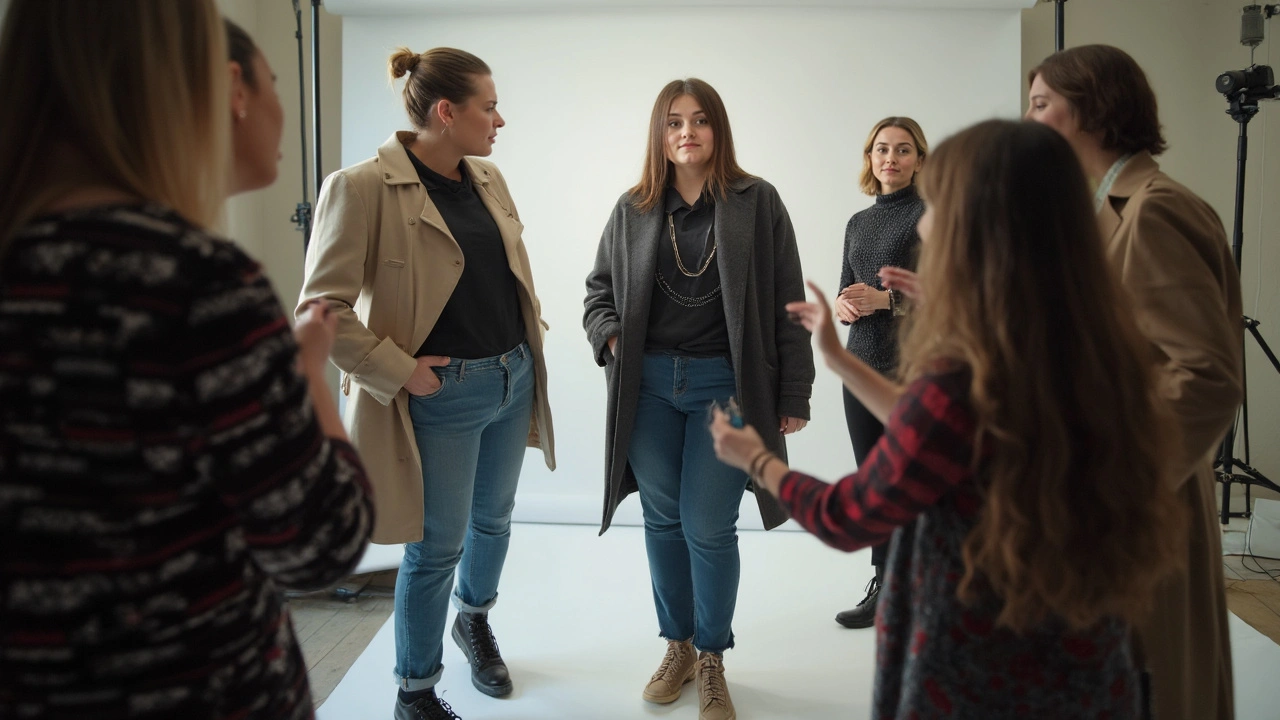
Nailing Wardrobe and Styling
The right wardrobe makes or breaks your model portfolio. You want outfits that highlight your shape, not hide it. Forget about baggy layers or trendy pieces that don’t suit you—clients want to see how clothes fit real bodies. Neutral colors usually work best. Black, white, denim, and muted tones help your features stand out and keep the attention on you, not your clothes.
Keep your looks simple, but not boring. Bring at least one outfit that hugs your body and lets lines and curves show. Try jeans and a basic tee for casual shots, a body-hugging dress for a night-out look, and something business-casual if you’re aiming for commercial gigs. This way, brands know you can switch it up for all types of jobs.
Avoid wild prints or logos—they just distract. Go with solid colors or super subtle prints if you really want to switch things up. For styling, stick to minimal jewelry and shoes that work with each look. For plus-size models, a lot of stylists recommend shaping underwear, not to change your size, but to give clean lines under fitted clothes.
You don’t need to splurge on fancy brands. Stores like H&M, ASOS Curve, and Target offer plus-size sections with basics that look good in photos. A 2023 Statista report found that 41% of plus-size women shop at places like these for shoot-ready basics, so you’re in good company.
- Bring clothes that fit you right now—not what you want to fit into someday.
- Pack backup underwear (think nude and black), plus a strapless bra if you’re planning on anything off-the-shoulder.
- Your shoes should be clean and neutral—nude or black heels work for almost any look.
- Keep makeup natural and glowy; natural brows and soft lips are trending for plus-size model portfolio photos.
| Wardrobe Tip | Why It Works |
|---|---|
| Solid Colors | Focus stays on you, not loud prints |
| Fitted Clothes | Clients see your real shape and posture |
| No Big Logos | Makes you more "brand-neutral" for agencies |
| Comfortable Shoes | Helps you move, try poses, and look confident |
When you’re comfortable and your outfits fit well, you’ll look way more confident. The goal is to show how real clothes sit on a real, plus-size body—don’t let old-school fashion advice scare you away from showing skin or wearing bolder looks if that’s your style. Just keep things crisp, clean, and true to you.
Posing and Confidence Tips
Standing out as a plus-size model is all about showing presence on camera. Agencies and brands don’t want stiff, awkward poses—they want real, natural movement that shows who you are. The best portfolios capture different moods: happy, serious, bold, thoughtful. Don’t just copy standard poses; find a few you’re comfortable with, then build on them.
Here’s an industry tip: modern casting teams wish you’d practice at home in front of a mirror. Find your best angles, experiment with hand placement, and get used to your face in different emotions. Plus-size model Marquita Pring said it best:
“The strongest shots always happen when I stop trying to pose and just move. When you’re comfortable, it shows.”
When you’re on set or taking photos at home, keep these practical moves in mind:
- Elongate your body: Stand tall, pull your shoulders back, and lean ever so slightly toward the camera—it adds energy.
- Find your strong side: Everyone has one angle that feels more natural or looks great. Use it, but don’t get stuck in just one pose.
- Hands matter: Keep them relaxed. You can gently touch your hair, pocket, or side of your face for a casual feel, but lose the stiff fingers.
- Change up expressions: Bookers want more than one look. Smile, smirk, get serious, try laughing—just avoid a fake smile for every photo.
If you get stuck or feel awkward, try moving between each shot. Walk, spin, laugh, and shake off nerves. A good photographer will keep shooting while you move, which often lands the most spontaneous, attractive images.
It’s normal for new models to feel nervous, but confidence is a skill. According to a 2024 Model Alliance survey, 67% of successful plus-size models said that regular practice in front of the camera was their top tool for boosting confidence. And don’t forget: agencies always notice models who can sell clothes and emotion, not just a look.
| Tip | Why It Works |
|---|---|
| Move naturally | Keeps shots fresh and relaxed |
| Switch up moods | Shows wide range to scouts |
| Practice with a mirror | Finds best angles, builds comfort |
If you remember one thing, make it this: your attitude shows up in photos. When you’re comfortable in your skin and not trying to hide, people notice—even through a lens.
What to Avoid: Rookie Mistakes
Mistakes happen, especially when you’re new to building a plus-size model portfolio. But some are way too common—and they can actually stop agencies or brands from taking you seriously. Let’s check out the main pitfalls and how to dodge them.
- Overediting your shots: Remove too many blemishes or smooth out skin too much, and you end up looking unnatural. Pros can spot heavy filters a mile away. Kelsey Foster, a well-known casting director, says:
“Agencies want to see the real you. Heavy retouching just raises red flags and makes us question what you’re hiding.”
- Posing in just one style: Only serving the same smile, angle, or look in every picture won’t cut it. Show you have range—serious, laughing, soft, confident. Variety matters more than being perfect in every frame.
- Wearing clothes that don’t fit: Baggy outfits or pieces that are too tight hide your shape and make it harder for clients to imagine you in their stuff. Choose outfits that actually fit and highlight your best features.
- Too many group or selfie shots: Your book is about you. Group photos or mirror selfies can make you look unprofessional. Agencies like to see crisp solo shots taken by someone else.
- Skipping basic info: Leaving out your measurements or only using old, outdated photos confuses scouts. Accurate info and recent images show you know what you’re doing.
Some quick numbers worth knowing: according to a recent 2024 Model Alliance survey, 78% of agency scouts won’t even contact you if your photos are obviously edited or missing basic info.
| Rookie Mistake | % Scouts Dissuaded |
|---|---|
| Overedited photos | 78% |
| Repeating same pose | 62% |
| No measurements listed | 74% |
| Too many group/selfies | 65% |
| Outdated photos | 59% |
The takeaway? Keep it honest, keep it current, and let your true personality show. Your portfolio should make it easy for someone to imagine booking you for real work.
